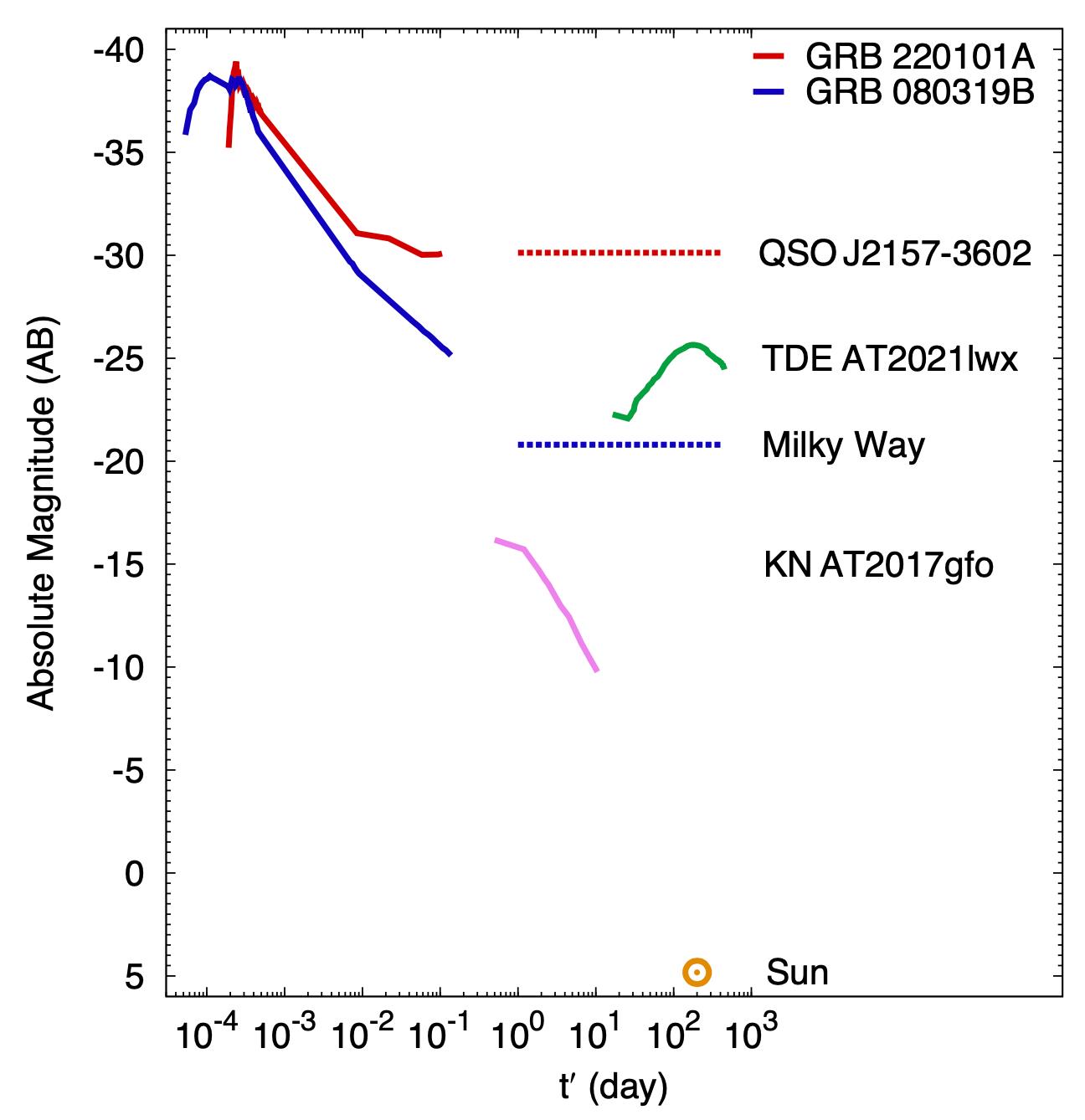GRB 220101A: Breaking the 14-Year-Old Record on the Absolute Magnitude of the Ultraviolet/Optical Emission
Gamma-Ray Bursts (GRBs) are the most violent explosions in the universe. Their prompt radiation is mainly in the soft gamma-ray band and last shortly (i.e., from milliseconds to at most hours). After the prompt emission, there comes the X-ray, optical and radio afterglow emission lasting for weeks or even years. In the late phase of the prompt emission of GRB 990123, a very bright optical flash was observed, and had been widely attributed to the onset of the afterglow radiation. At that moment, this optical flash also set the record on the luminosity of the ultraviolet/optical emission in the universe. This record had been broken in 2008 by the prompt optical emission of GRB 080319B, a burst at a redshift of 0.937. Its peak visual magnitude reaches 5.3, which is so bright that an observer in a dark location could have seen it with the naked eyes. Unlike GRB 990123, the optical flare radiation from GRB 080319B traces the gamma-ray light curve and hence the activity of the central engine. In the past decade, no similar or even comparable events have been reported. Moreover, all these giant optical flares were discovered by the ground-based telescopes.
On New Year's Day in 2022, the Swift satellite detected a new burst, GRB 220101A. The redshift of GRB 220101A was measured to be 4.618. At such a high redshift, the observed optical photons were in ultraviolet band and suffered from very serious absorption. Consequently, the intrinsic radiation flux is about 100 times higher than the observed value. Just 79 seconds after the burst, Swift/UVOT performed a quick 150-second observation in the event mode in the White band. The authors carried out a high time resolution photometric analysis and revealed a rapid evolution of the flux. In particular, at the peak time the UVOT telescope was already moderately saturated. For such data there is no reliable analysis method in the literature. The authors proposed a processing method for UVOT data, based on the telescope's point spread function, and verified that it indeed provides reliable flux measurements. After the proper distance and absorption corrections, the absolute magnitude of the ultraviolet/optical emission of GRB 220101A reached -39.4, making it the only source to date with an absolute magnitude brighter than -39. It is also the first time to detect an extremely energetic ultraviolet/optical flare with a space telescope. As shown in Figure 1, the luminosity of GRB 220101A is approximately 400 quadrillion times that of the Sun, which also breaks the 14-years old record held by GRB 080319B. Moreover, the optical radiation behavior of GRB 220101A is different not only from the optical-ultraviolet flash that marks the beginning of the afterglow in GRB 990123, but also from the direct tracing of the central engine activity seen in the optical-ultraviolet flash of GRB 080319B. It thus suggests a new astrophysical process, demonstrating the diversity of the physical origins of super-bright optical-ultraviolet bursts. The China-France Space Variable Objects Monitor (SVOM) satellite, scheduled for launch in early 2024, is expected to be able to detect extremely energetic ultraviolet/optical flares at even higher redshifts.
This work was supported in part by the National Natural Science Foundation of China and ASI.

Fig. 1 A comparison between radiation of the ultraviolet/optical flare of GRB 220101A, the Sun, the kilonova AT 2017gfo, the Milky Way, the tidal disruption event AT 2021lwx, the quasar QSO J2157-3601, and the ultraviolet/optical flare of GRB 080319B. At its peak, the ultraviolet/optical luminosity of GRB 220101A is approximately 400 quadrillion times that of the Sun. (Image by JIN Zhiping et al)